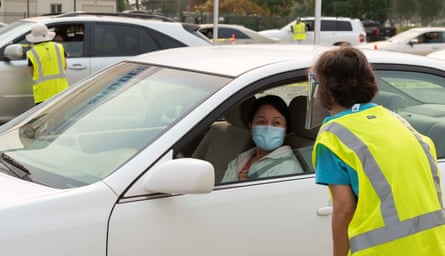Like many working mothers, the first months of the pandemic were a nightmare for Andria Kemp-Sellers. The state of California declared her husband’s job at a sugar factory essential, so he continued to go in for 12-hour shifts. She stayed at home in Vallejo, juggling raising their three children and teaching 25 four- and five-year-olds online in Oakland.
‘I’m not stressed’: guaranteed income programs are changing the lives of American parentsRead more
“The kids were eating me out of house and home because they were bored,” Kemp-Sellers said, laughing. “Eating became an event!”
Even with two parents working full-time in unionized jobs, the family struggled to afford the basics. They needed high-quality internet for their children’s schooling and her teaching, which wasn’t cheap – about $50 a month. Along with their food costs, their electric bill also went up. Kemp-Sellers, who grew up in Oakland but left after getting priced out, took on extra work and cut back in other areas. But the family still struggled to keep up.
“It’s a terrible feeling when you have to essentially introduce poverty to your kids,” she says. “When you have to explain: ‘well, I could make you that extra peanut butter sandwich, but then we won’t have any bread for tomorrow.’
It’s a terrible feeling when you have to essentially introduce poverty to your kidsAndria Kemp-Sellers
“It does something to your psyche as a mother. It makes you ashamed.”
When the federal child tax credit – $500 for each child – arrived in the mail, it was “a saving grace”, she said. The Pandemic EBT card – a federal program that supplied $200 a month a child for food to parents with school-age children who would have otherwise qualified for free and/reduced lunch – also helped the family to get through.
Then came the Golden Gate Stimulus – a one-time $600 or $1,200 payment each tax return for residents of California who earned less than $75,000. It was the biggest direct cash payout a state has ever offered taxpayers, ultimately reaching 8.4 million people. A childcare subsidy also came as part of the relief package. For a brief moment, Kemp-Sellers felt she had room to breathe.
 View image in fullscreenGolden Gate Stimulus was a one-time $600 or $1,200 payment each tax return for Californians. Photograph: Simone Hogan/Alamy
View image in fullscreenGolden Gate Stimulus was a one-time $600 or $1,200 payment each tax return for Californians. Photograph: Simone Hogan/Alamy
The impact of the relief initiatives led anti-poverty advocates to call for them to be made permanent. Instead, these state and federal relief dollars have all but disappeared, with critics saying the policies are too sweeping and should instead be targeted towards a middle class struggling to cope with inflation.
Today, only the childcare subsidy remains. But that too is set to expire this June, setting up a confrontation between a state legislature which overwhelmingly supports making the subsidy permanent and a governor strongly opposed to doing so.
The legislature has already had one effort rebuffed. Last year, a bill by assemblywoman Eloise Gómez Reyes, Democrat from San Bernardino, was passed with no dissenting votes and strong support from parent and child care advocates. Gavin Newsom, the California governor, vetoed the bill in September, saying it would be too costly.
Those pushing to make the policies permanent say the consequences of ending programs that buoyed so many women of color and their families during the pandemic – particularly Black families – could be profound: the loss of jobs and homes, hungry bellies, toxic stress.
“At the end of the day, politicians and policymakers still do not trust Black and brown women to do what’s best for their families,” says Jhumpa Bhattacharya, founder of the Maven Collaborative, a grassroots organizing group centered on Black women.
A time of unprecedented aid
This wasn’t the first time Kemp-Sellers had to face up to harsh financial realities. Though she teaches transition kindergarten at a public school in Oakland, the city where she grew up, rising rents forced her to move to nearby Vallejo in 2013.
When some of these women got a little check in the mail, you best believe it went to good use … That little check changes the whole game. They stretched every dollar Keta Brown
She’s not alone. A recent study of the Bay Area found that 58% of women of color are “housing cost-burdened” – a federal designation for households that spend more than 30% of their income on rent or mortgage. California’s housing shortage is the leading cause of poverty and homelessness in the state, and experts warn that the displacement of women of color like Kemp-Sellers is especially damaging as they act as an informal support system that keeps their communities alive.
“What people don’t understand is that another pandemic was happening before the [Covid-19] pandemic – the pandemic of economic struggle for the people who, as soon as the check comes in, it’s going back out,” says Keta Brown, a Black mom raising four kids in Oakland.
Brown knows the “pandemic of economic struggle” first-hand; now, as an organizer who helps mostly Black, single moms advocate for their children’s educational rights, she saw how Covid-era relief helped some women get by.
“When some of these women got a little check in the mail, you best believe it went to good use. They’re calling PG&E [the electricity company] and saying, ‘I know I owe $300. I can send you $100 now and you keep the lights on. I’ll send more later,’” she explains. “That little check changes the whole game. They stretched every dollar.”
The pandemic hit these women of color hard. Black, Latinx and most other women of color suffered disproportionately – struggling to juggle jobs and kids out of school, and working risky and unpredictable jobs in retail, food services and the in-home care space.
These women were often not set up to weather a financial crisis. And during these last two years, more than 40% of women of color in the state struggled to pay housing costs or afford food, according to the California Budget and Policy Center, compared to 29% of white women. In fact, this was the first recession in which more women than men lost jobs, and Black and Latinx women and women who are immigrants lost their jobs at especially high rates in the early months of the pandemic.
 View image in fullscreenA woman talks with a volunteer at a drive-thru food giveaway at Mile Square regional park in Westminster, California. Photograph: MediaNews Group/Orange County Register/Getty Images
View image in fullscreenA woman talks with a volunteer at a drive-thru food giveaway at Mile Square regional park in Westminster, California. Photograph: MediaNews Group/Orange County Register/Getty Images
Inflation is only making things worse. About one-half of Black, Latinx, and other Californians of color reported struggling with basic expenses in recent months, compared to about 30% of white Californians.
The impact isn’t just economic: half the women in the state report experiencing symptoms of anxiety and depression. Among women suffering through multiple hardships, such as the loss of household income or the inability to pay for food or housing, as many as three-quarters report these symptoms.
But the pandemic has also been a time of unprecedented aid.
Federal stimulus payments prevented 1.7 million Californians, particularly people of color, from falling below the poverty line between 2019 and 2020, according to the Public Policy Institute of California. Unemployment insurance helped an additional 1 million Californians avoid poverty.
The state itself – one of the largest economies in the world – pushed through an array of support programs. On top of the Golden Gate Stimulus payments, California offered critical rent relief of nearly $4bn to about 431,000 households so far, and eviction protections.
The state also provided childcare subsidies and led the way nationally when it permanently repealed a series of controversial legal fees, including what states call “supervision and programming fees” – whereby people on probation or parole have to pay for their own mandatory supervision, drug testing and electronic ankle monitoring. These fees disproportionately hurt already vulnerable families of color.
The relief measures seem to have made a difference. The Public Policy Institute of California found that disparities in poverty between minority groups and whites narrowed during this period – particularly for Latinos. In 2019, Latinos were 2.3 times more likely to be in poverty than whites, compared to 1.8 times more likely in 2020.
Researchers have found that the expanded child tax credit reduced child poverty nationally by 26% compared to pre-pandemic levels. Childcare is the highest household expense in all California counties, except for five Bay Area counties that have the state’s highest housing costs.
During this time, the poverty gap between whites and other racial demographics narrowed. The Public Policy Institute of California found that disparities in poverty between minority groups and whites narrowed during this period.
These numbers led to a push among many local groups to make pandemic-era policies permanent. What took place was the opposite – the state has allowed almost all of the initiatives to expire.
A battle over who deserves the money
At the heart of the dispute is disagreement over what type of role the state should play in providing support. Opponents of extending the policies say the state has misplaced its priorities with such universal programs, instead demanding more targeted policies such as an also controversial gas rebate proposal that would be much more focused on helping middle-class voters.
“California can’t afford to waste state resources providing unneeded assistance to those with higher incomes, assets and wealth. Instead, policymakers have a responsibility to provide targeted relief using proven paths to the children, families, and individuals blocked from the opportunity to thrive in our communities,” wrote Sara Kimberlin and Alissa Anderson of the California Budget & Policy Center, arguing that the universal nature of the relief programs funnel money towards more well-off families who don’t need it.
Supporters of extending the policies believe opponents are acting out of their own unchallenged bias, noting that the state’s relief programs have been crucial in helping middle-class women like Kemp-Sellers survive. From their perspective, the argument that the relief efforts unnecessarily help rich families is a smokescreen to bash programs that in practice overwhelmingly support poor families and people of color.
Candice Elder, an Oakland native and executive director of the East Oakland Collective, a group that advocates for food security, says her group has had to become more creative since state support dried up in March, grabbing leftover meals from empty Silicon Valley offices or from food festivals. But that hasn’t been enough to meet the needs of the community.
“We’ve had to tell some of our elders, ‘You can come in for hot food on Mondays, but that’s it. We no longer have hot meals to provide on other days. You gotta stop coming other days’,” Elder says.
Many extension advocates look to New Mexico as an example of a state that’s doing it right, or at least better. In early 2020, the state spent $300m to create an Early Childhood Education and Care Fund – an endowment which draws on oil and natural gas taxes. It is projected by area lawmakers to be worth $4.3bn by 2025. A new program, which started on 1 May, makes childcare free for most residents (families of four can earn up to $111,000 and still be eligible) through June 2023, what Michelle Lujan Grisham, the state governor, calls the next step on the road to universal free preschool for the state.
For women like Kemp-Sellers, a little support meant basic dignity.
“When we had that extra money, it actually helped me learn who my children were. I could take them to the grocery store and say, ‘Pick out what sounds good to you,’ and they loved knowing, ‘These are my strawberries. I picked them out and I can eat them,’” she said. “If only we could live like that all the time.”
The Golden State is expected to overtake Germany as the world’s fourth-largest economy this year, but not all of this wealth is being shared equally. In this series, the Guardian and the Fuller Project look at the lives of women, especially women of color, who help drive the economy of the US’s second-most racially diverse state but don’t get their fair share of the pie.
-
This article is published in partnership with The Fuller Project, a non-profit newsroom dedicated to the coverage of women’s issues around the world. Sign up for the Fuller Project’s newsletter, and follow the organization on Twitter or LinkedIn.





